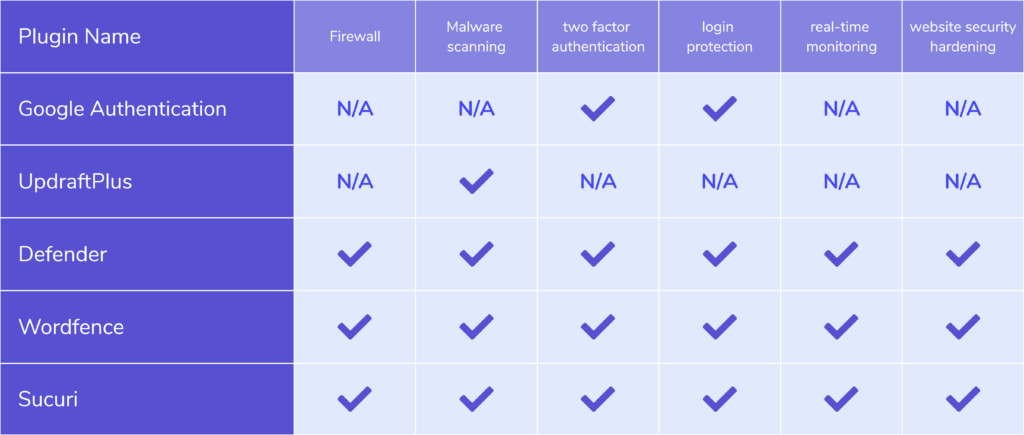WordPress is one of the most popular website platforms in the world and for good reason. It’s user-friendly, flexible, and highly customizable. However, with great popularity comes a greater risk of security threats and attacks. That’s where WordPress security plugins come into play. There are a variety of security plugins available, each with its own set of features and benefits, so choosing the right one can be quite a challenge. In this article, we’ll compare five WordPress security plugins, including Google Authenticator, UpdraftPlus, Defender, Wordfence, and Sucuri. We will go deep into the differences and benefits of these plugins to make things clearer.
If you need help making an informed decision about which plugin might be right for your website, you have come to the right place.
The importance of security
As mentioned above, WordPress is highly popular and its demand is rising every day (according to W3Tech, since 2011 WordPress usage has increased by 12% per year. As of 2023, around 810 million websites use WordPress, which is around 43% of all the websites). That said, the platform is still vulnerable to cyber-attacks. Let’s take a look at some of the threats:
- According to a study by Sucuri, in 2020, over 90,000 WordPress websites were attacked each day. Based on this security provider, 90% of its cleanup requests came from WordPress websites; 39% of the hacked sites were using an outdated version of the software.
- WordPress websites are often targeted by hackers because they are vulnerable to a variety of attacks, including brute force attacks, cross-site scripting (XSS) attacks, SQL injections, and more.
- In addition to hacking attacks, WordPress websites are also vulnerable to other security threats, such as malware infections and DDoS attacks.
This is why security issues top the list of concerns for both new and experienced WordPress site owners.
This information highlights the importance of taking WordPress security seriously and implementing strong security measures to protect your website. Installing a WordPress security plugin is one way to improve your site’s security, but it’s important to also keep your plugins and themes always up to date.
I’m not just talking about a hypothetical. Websites can and do get infected with viruses and malware—and plugins can be the solution you need if you’re facing this unfortunate situation.
Bobby King, COO of WLA recalls one such incident: “A couple of years back we had a new client that came to us with an infected site. The site had the Japanese Keyword Hack. […] They installed one of the plugins and subscribed to their Basic plan. The plugin scanned and identified the issue. After about 4 hours it was completely cleaned and the client left the plugin and service on the site to continually monitor and check it.”

WordPress plugins
Using a security plugin is the most efficient approach to enhancing the security of your website. Most of the plugins mentioned below are relatively easy to install on a WordPress website. They can be installed directly from the WordPress plugin directory or uploaded manually. Some of the plugins may require additional setup steps, such as connecting to an API or configuring settings, but the installation process itself is generally straightforward. From our experience, most of the customers do not request to install plugins from us but rather do it themselves after migrating the website.
With a wide range of plugins around, I have compiled a list to help you navigate all the similarities and differences:
Google Authenticator
Google Authenticator is a security plugin for WordPress that adds an extra layer of security to your website through two-factor authentication. Many of our customers ask us to give some tips on how to improve their security, and the statistics answer the question: It’s estimated that 8% of WordPress websites get hacked by weak or stolen passwords. So it’s always better to have a hard-to-remember password and note it somewhere rather than having “ABC123” types of combinations.
With this plugin, users are required to enter a verification code in addition to their password to access their account, which helps to protect against hacking and unauthorized access. It can also be used for protection against brute force attacks, which are a common form of hacking where attackers try to guess a user’s password by trying multiple combinations of characters. With two-factor authentication, even if an attacker guesses a user’s password, they still won’t be able to access the account without the verification code.
Google Authenticator is free to download and use.
UpdraftPlus
UpdraftPlus is a backup and restore WordPress security plugin that helps protect your website against data loss and security threats. In addition to its backup and restore features (the plugin offers several backup storage options, including Google Drive, Dropbox, Amazon S3, and more, all of which offer secure data storage), UpdraftPlus also includes several security features. Let’s take a look:
- Encryption: The plugin offers encryption options for your backups to help protect your site’s data even further. With encryption enabled, your backups will be protected from unauthorized access.
- Malware scanner: UpdraftPlus includes a built-in malware scanner that can help detect and remove malware from your site.
- WordPress multisite support: UpdraftPlus supports WordPress multisite installations, making it easy to back up and restore multiple sites from one central location.
There is a free version of UpdraftPlus available for basic features and the premium version of the plugin starts at $42 per year.

Defender
Defender is a security plugin that includes both proactive and reactive security measures to help keep your site safe.
Here are some of the security features of Defender:
- Firewall: Defender includes a web application firewall (WAF) that can help prevent attacks on your site. The firewall is designed to block common attack patterns and protect against common vulnerabilities.
- Malware scanning: Defender includes a built-in malware scanner that can help detect and remove malware from your site.
- Two-factor authentication: Defender supports two-factor authentication (2FA) for WordPress login to help prevent unauthorized access to your site.
- Login protection: Defender includes login protection features to help prevent brute force attacks on your WordPress login page.
- Reporting and analytics: Defender includes reporting and analytics features to help you stay informed about potential security threats to your site. The plugin can send email notifications when potential threats are detected and provides detailed reports on security events.
Defender plugin is part of the WPMU DEV membership, which starts at $49 a month and includes access to all of their plugins as well as 24/7 support and website hosting.
Wordfence
Wordfence plugin includes a combination of preventive and reactive measures to keep your site safe. Just like Google Authenticator and Defender, it provides malware scanning, two-factor authentication, login protection and real-time monitoring.
Wordfence also provides blocking features, that can prevent malicious traffic from accessing your site. The plugin can block IP addresses, countries, and specific user agents to help protect your site from known threats.
There is a free version of the plugin. A year membership starts at $99.
Sucuri
Sucuri is a WordPress security plugin that includes a combination of preventive and reactive measures to keep your site safe. This security plugin features all the protection mentioned that is combined in all 4 security plugins. (Firewall, Malware scanning, Two-factor authentication, Login protection, Real-time monitoring).
Sucuri can also harden your website’s security by implementing various security measures, such as enforcing secure passwords and disabling unnecessary features. It also includes a content delivery network (CDN) that can help improve your site’s performance and security by caching your site’s content and serving it from servers located around the world.
The premium version of Sucuri starts at $199 per year, but there is also a free version of the plugin.
Plugin comparison
Website security is a critical concern for any website owner, regardless of the size or nature of their website. WordPress, being the world’s most popular content management system, is especially vulnerable to cyber-attacks. Fortunately, many WordPress security plugins have been created to save the day.
When choosing a security plugin for your website, it’s important to consider your specific needs and budget.
With over 50,000 plugins available on the WordPress plugins repository, the seemingly simple task of choosing the right one can become exhausting. While some plugins may be free, others may require a subscription or one-time payment. Of the ones we highlighted, all of them have free versions, and the price of their premium versions ranges from $42 – $199 per year. Additionally, you should consider factors such as ease of use, support options, and compatibility with your website’s existing plugins and themes.




